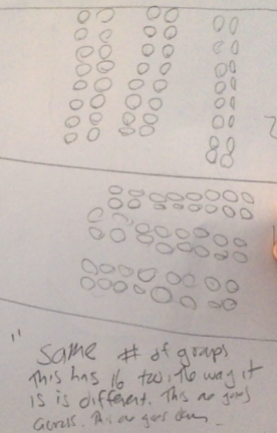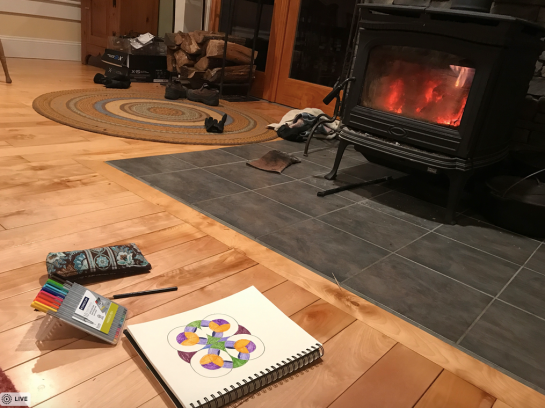I have been thinking about trying to use Desmos with elementary students for a while now, but I was struggling to commit. Honestly, I wasn’t sure if I trusted it. Would it amplify the learning or just be another fingerprinted screen? Mostly, I have used Desmos as a learner. I play with the graphing tool to help me see patterns, build my intuition, make connections, etc. Once, when I was trying to deepen my understanding of repeating decimals, I asked for help on Twitter. Christopher Danielson gave me something to play with.

I explored for a while.

Here is a screenshot of something else I was exploring on Desmos once. I don’t remember what it was. It is rough draft thinking. I was just playing around.

I have used a few Desmos activities with Middle School students and teachers. I have played around with the teacher platform a lot, but, like I said, I had trouble committing.

This week, I finally tried it. During a 3-5 grade span meeting, I shared, planned and taught a polygraph that I created. A group of us went into a third grade classroom together to investigate this questions:
How do we know if technology has amplified the learning?
I spent a chunk of time preparing for this experience. The first thing I did was connected with the third grade teacher with whom I would be working, Ms. M, and I shared my thinking. We agreed to have the students try a different polygraph the next day so they would be familiar with the routine. We settled on a polygraph called Kittens because it wasn’t explicitly “math-y”. We wanted them to focus on the structure of the activity and “try on” the important characteristics of the Polygraph game: asking and answering questions and using deductive reasoning.
We also talked about which polygraph to use during the grade span meeting. I told her I wasn’t really sure that any of the polygraphs I had found were the right ones. I was hoping to find one that elicited big ideas about multiplication and division because that is what the students are investigating in class right now. The only one I found was a multiplication practice task. It didn’t seem like a good fit. I wasn’t as interested in exploring the potential of Desmos to help students practice a skill. I wanted to see whether or not Desmos amplified deep understanding of a concept. Ms. M and I agreed that, over the weekend, I would create a polygraph that was made up of arrays. (As I am writing this, I re-discovered Michael Wiernicki’s Arrays Polygraph. It looks similar to the one I created, but with area models instead of dots. Maybe a next step for us?)
The next day, I stopped by math class while the students were playing Kittens. Each pair of students had an iPad. They were having fun; trying to figure out who they were playing against, talking about how cute the kittens were, trying to think of questions to ask that would eliminate kittens. There were some arguments starting to bubble up.
“Hey! You said it wasn’t a fluffy cat!”
“It isn’t. That cat isn’t fluffy.”
“Yes it is!”
“It isn’t as fluffy as the other cats.”
We talked a little bit about why “fluffiness” was subjective and collected a few questions that were not as subjective. Ms. M and her students had no problem accessing Desmos and getting into the game.
Last Sunday, I sat down to create a an array Polygraph. First, I asked myself, what big mathematical ideas do I want this activity to illuminate? Here is where I landed. (You can click here for a link to my whole planning doc.):
 I opened Powerpoint and started messing around with arrays. The first few images I created only had 6 dots in them.
I opened Powerpoint and started messing around with arrays. The first few images I created only had 6 dots in them.

I wondered what kids would do with these images. What kinds of questions would they ask to distinguish between the images?
- Does your card have 2 rows?
- Does your card have 3 columns?
What if they don’t know the terms rows and columns or maybe they have heard them but aren’t using them – they don’t “own” them, yet? Maybe they would say “groups”.
- Does your card have 3 groups of 2?
At this point I wondered if I would have to use numbers other than 6. Polygraphs need 16 cards. Could I make 16 different representations of 6 dots? I might be able to, but would the polygraph still illuminate the ideas I mentioned above? I wasn’t sure, but my gut told me to stick with one number. I decided to try a bigger number. I ended up using 48 dots to create 16 different representations. Actually, one of them has 36. I lost two groups of sixes somewhere amidst the copying and pasting. I noticed the lone group of 36 while I was playing my first round of Polygraph: Arrays with my friend Jocelyn Dagenais. Here is what is great about #mtbos: on Monday morning, I tweeted this:

Within minutes, Jocelyn and I were playing a game of Polygraph: Arrays. Later that night, Laura Wageman and her daughter played a round. Laura also shared a great resource for finding other Elementary Desmos tasks. Many other folks helped me out. Dianna Hazelton shared a slide show that she presented to teachers earlier in the day. Jenna Laib and Lana Pavlova gave me some feedback. Jessica Breur, a Desmos fellow, checked in with me to let me know that she was interested in hearing how the lesson went. Wow. That is a ton of support. Great stuff.
Later that night, I played the Polygraph with my 8-year-old son. Playing with Max was really helpful because I got to see what kinds of questions he asked. Below is a screenshot from the teacher dashboard. His sister was helping him type.

At one point, he asked me if my card equaled 48. I said yes.
He said, “Oh! I know which one it is.” Then, he paused. He looked at the cards that were left and started thinking out loud, “8 and 8 is 16. 16 and 16 is 32 plus another 16 is………oh no. That is 48 too.?” This was a cool moment. Is it evidence of amplification? I don’t know. Would Max have had a similar moment if he and I were playing the same game with paper cards? Maybe.
After playing with Max, I spent some time anticipating what questions other third grade students might ask:

Then, I thought about how I might connect student learning.

Finally, I felt like I was ready to try this Polygraph with a group of students and teachers. I made a Google Slide presentation for our meeting the next day. Looks great on paper. Then, reality set in. We only had two and a half hours for the whole meeting. The meeting started at 7:50. The third graders had to go to Art at 9:00. I wanted the teachers to try the activity first. I wanted them to anticipate student questions and brainstorm ideas for connecting student thinking. The third graders needed at least thirty minutes to try the task. I am not know for my punctuality. How the hell was I going to squeeze any meaning out of this meeting/lesson?
As soon as the teachers came in, I told them to sit with a partner and one computer, go to the website on the board, and type in the code. Each team was able to finish one round.

We discussed what big Math ideas this activity might elicit. The teachers shared the types of questions they thought students would ask. We briefly discussed some ideas for connecting student work. Then, we headed down to third grade. This is when things got interesting.
The kids got right into the game. They were familiar with the platform. They had no trouble signing in. Immediately, they noticed I had anonymiz-ed them.
“Who is Katherine Johnson?” somebody called out as they looked around the room.
I explained that I had used Desmos to randomly assign them fake names. They seemed fine with that and went back to their game.
The first round was really interesting. Many of the pairs picked the wrong card. A few guessed correctly. Some of them didn’t complete the game. Take a look at some screenshots from the class. What do you notice? What do you wonder?
I notice that the questions Katherine Johnson asked were very different from the questions Pythagoras asked. Katherine was thinking about ten frames. Pythagoras was thinking about groups. I wonder how this difference in perspective impacted the game? I wonder what Pythagoras means by “ten frame”. I wonder a lot about what these students know and understand. I am definitely grateful to have their questions captured on screen.
Throughout the class, we paused the game to check in about a few things. Every time I used it, the class erupted into a chorus of ,”Hey! What happened?” During pauses, we had some brief conversations about which questions were helpful and why. As I monitored, I conferenced with students about what they were thinking. The students who were guessing took some time to think of a question. I used it as an opportunity to model what I might think about if I was a “picker” waiting for my partner to ask a question. I huddled with one group and whispered, “I am trying to think about what questions they might ask. What questions do you think they might ask us?” Later, during the debriefing, the teachers mentioned the “pickers” had a lot of “down time” while they waited for questions to be asked. I wonder if down time is an opportunity to engage in the standards for math practice.
Towards the end of class, I paused everyone and asked them what they noticed and wondered so far:

The consensus was that Polygraphs can be challenging. Here is why:
- Sometimes, you write the wrong answer by mistake.
- Sometimes, you mis-understand what your partner is asking.
I asked, what can we do about these challenges? One person said, “We can read the question twice.” I asked, “Is there anything else we can do?”
One girl spoke up, “You can think about what your partner meant.” I love this. Admittedly, I got pretty excited when she said it. I hadn’t anticipated it. I hadn’t thought about it before and she was spot on. Think about what your partner meant. Wow. What if we all did more of that? What if we really tried on each other’s thinking, not to judge it, but to get a different perspective.
It was time to wrap up. We were running late. I have been trying hard to not forget the lesson close so I tried to pull some of the pieces together. I asked everyone to turn and talk to their neighbor about what they think Sally meant when she said, “Some cards had the same number of groups, but a different number of dots in each group.”
Silence. No movement. The kids looked at me with blank faces. I repeated my prompt.
Nothing. I realized that these kids were not sure how to think about what their classmate meant. I told them what I thought she meant. Then, I asked Sally if I was rephrasing her thoughts correctly. She said I was. I asked the students to talk to each other about what they thought she meant. A few of them seemed to be making some connections.
Finally, before we left, I asked them to see if they could find an example of what their classmate meant. Could they find two cards that had the same number of groups, but a different number of dots in each group? Here is what they came up with:
After we got back from the lesson, we discussed what we noticed and wondered. One of my colleagues, Abby, said she wondered if Sally meant something different from what I had interpreted. She wondered if Sally was referring to different arrangements of the same number of dots. When we were in the classroom, Sally seemed to go along with my rephrasing. She nodded and smiled at me, as if to say, “Sure. What you say sounds great.” Was I really listening to Sally? Was I really trying to understand what she meant? Or did I hear something that sounded like the “big idea” I was looking for?
I don’t know.
During our debriefing, we discussed what we might do next with these students. We decided it would be meaningful to continue to use this Polygraph.
- We could use individual cards as Number Talk Image prompts.
- We could ask the students to sort the questions from the lesson into groups and discuss the characteristics.
- We could play another game – the teacher vs. the students.
- We could show the students the questions they asked and ask them what they would change.
- We could continue to have the students play this game – maybe once a week and monitor what strategies they were using to find the total number of dots per card.
- During the next round, we could look for opportunities to structure a Same, but Different Math conversation.
I am not sure if using technology amplified those third grade students understanding of multiplication, but it definitely amplified my own understanding of how to teach third grade students.














